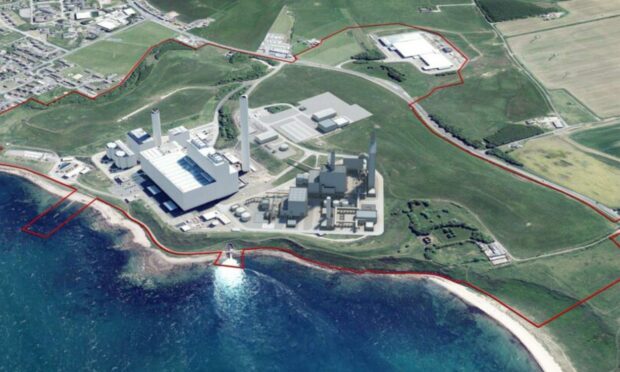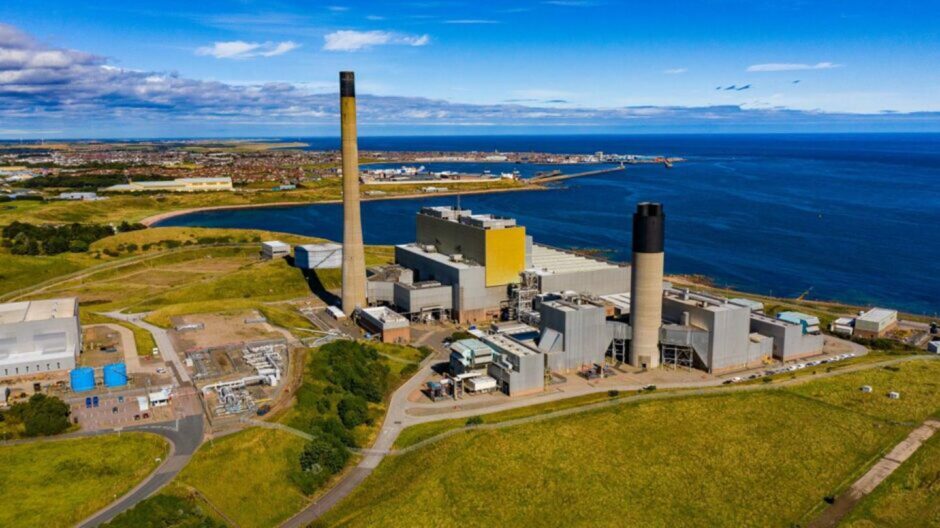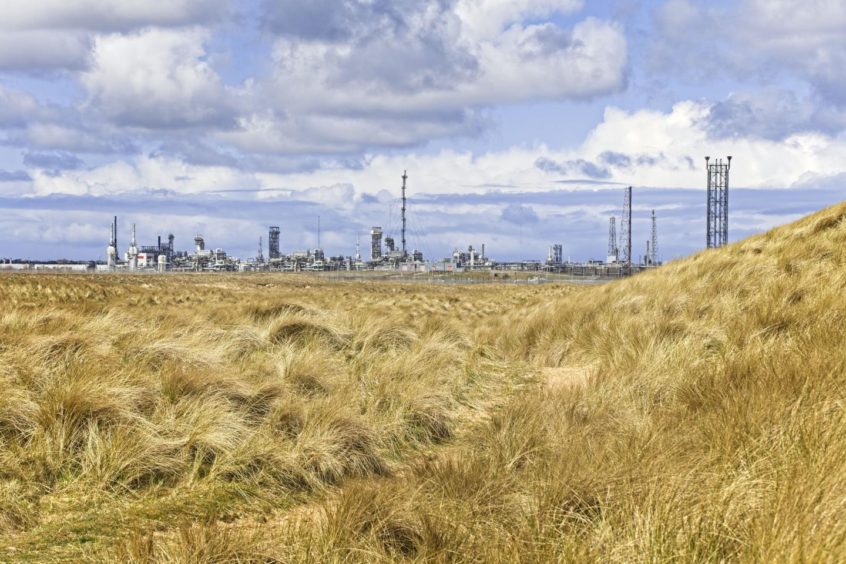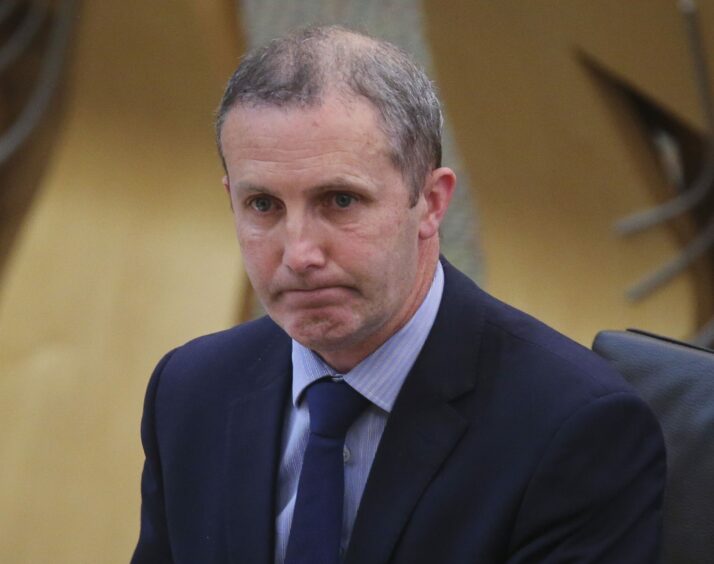A major project to capture and store carbon at a power plant in Peterhead could bolster the region’s finances by £60 million, a new report has found.
Further, the Peterhead Carbon Capture Power Station could add £1.2 billion to the UK-wide economy throughout its lifetime, according to analysis from BiGGAR Economics.
The carbon capture scheme is being developed by SSE Thermal, owner of the Peterhead power plant, and Norwegian energy giant, Equinor.
The pair expect the Peterhead facility could become one of the first to be equipped with the ability to capture carbon.
The plan is to build on spare land within the existing site of the gas-powered plant and ultimately the aim would be for the new station to replace the existing facility, SSE said.
It would connect to the Scottish cluster’s transport and storage infrastructure underpinned by the Acorn project, located just up the coast at the St Fergus gas terminal.
Benefits for local community
The ‘Powering the Next Generation’ report showcases the scale of the socio-economic benefits arising from the power station.
It is estimated that £2.2bn will be invested across the development, construction and first quarter of a century of the facility’s operational life.
Once fully active, the power station will prop up around 240 green jobs on an annual basis, and add around £25m to the local economy.
On a Scotland-wide level, the analysis shows that £190m would be added to the economy during development and construction, with 3,070 years of employment supported.
Across the lifetime of the station, an average of around £35m would be added to the Scottish economy each year, with 290 further jobs supported.
It is hoped that Peterhead Carbon Capture Power Station could be up and running as early as 2027, if the necessary mechanisms are put in place.
Carbon capture ‘necessity not an option’
Scotland’s net zero and energy secretary Michael Matheson said: “Carbon capture, utilisation and storage is critical for meeting, not only Scotland’s statutory emissions reduction targets, but those set across the UK.
“Indeed, advice from the Climate Change Committee describes the technology as a ‘necessity, not an option’.
“The innovative Peterhead CCGT Power Station is a fantastic example of how Scotland’s energy sector can make the transition to net zero and – as this study demonstrates – benefit the Scottish economy, providing employment and a just transition for our workforces.
“It shows just how important it is to invest now in carbon capture technology.”
He added the UK government must also support low carbon energy projects in the region.
Huge dismay met the UK Government’s decision to snub the Scottish cluster in a £1 billion funding competition last year which saw rival projects in “red wall” constituencies in the North of England awarded instead, leaving a range of low carbon energy projects in Scotland, including Acorn, as a so-called “reserve cluster“.
Storegga, the leader of the Acorn carbon capture and hydrogen projects at St Fergus, recently announced it has raised over £50m in a third funding round to back its portfolio of international projects including those in the north-east.
Mr Matheson said: “Which is why the UK Government must award the Scottish cluster clear and definitive track-1 status.
“We continue to press them to reconsider their decision and work in collaboration with the Scottish Government to accelerate support for the energy transition in Scotland.
“This includes offering £80 million under our Emerging Energy Technologies Fund to accelerate the cluster’s deployment.”
At a UK level, the BiGGAR Economics report forecasts £470m will be added to the economy through development and construction, as well as 7,850 years of employment.
On an annual basis once operational, the plant would contribute an average of around £50m to the UK economy and support 560 jobs.
Once operational it could capture an average of one and a half million tonnes of carbon a year – about 5% of the UK Government’s 2030 target for carbon capture and storage (CCS).
Peterhead is vital to Scotland’s energy system.”
Catherine Raw, managing director for SSE Thermal
Catherine Raw, managing director for SSE Thermal, said: “Peterhead is vital to Scotland’s energy system and we are committed to delivering a secure and credible transition to net zero by building a new low-carbon power station at the site.
“The proposed Peterhead Carbon Capture Power Station would provide essential flexible and reliable power to keep the lights on and back up Scotland’s world-leading renewables sector, while helping to meet our climate action targets.
“But the benefits stretch even further as we look to maximise the positive impacts of the energy transition for workers and communities in the north-east of Scotland.”
She added that the group would “push ahead” with the plans for the gas plant while the fate of the wider Scottish cluster was being decided.
“While we await clarity from the UK Government on the timeline for deployment of the Scottish cluster, we are pushing ahead with our development plans, and last month we submitted a planning application for the new low-carbon plant – which as this new report shows, has the potential to be a game-changer for the region and for Scotland,” she said.
Grete Tveit, senior vice president for low carbon solutions at Equinor, said: “Peterhead Carbon Capture Power Station is a significant project that will get the UK closer to its net zero goal, while also working alongside intermittent renewables and enhancing low-carbon energy security.
“Together with our longstanding partner SSE, we’re committed to delivering our hydrogen and CCS projects such as Peterhead Carbon Capture Power Station to help Scotland and the UK become a world leader in low carbon technologies.
“While supporting the decarbonisation efforts, this project will also offer great benefits for the local economy and supply chain, safeguarding high-value jobs and creating new ones.”





Conversation